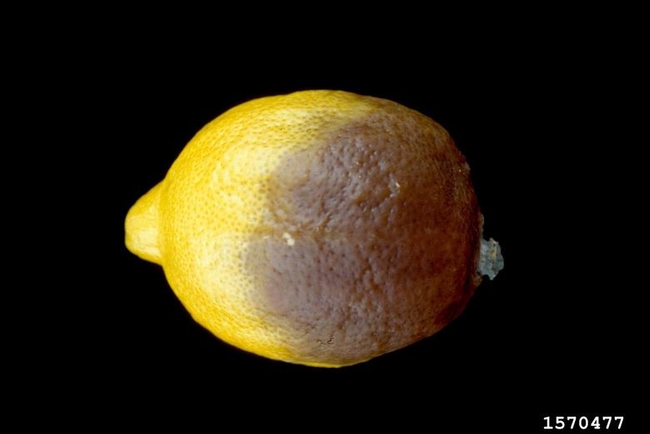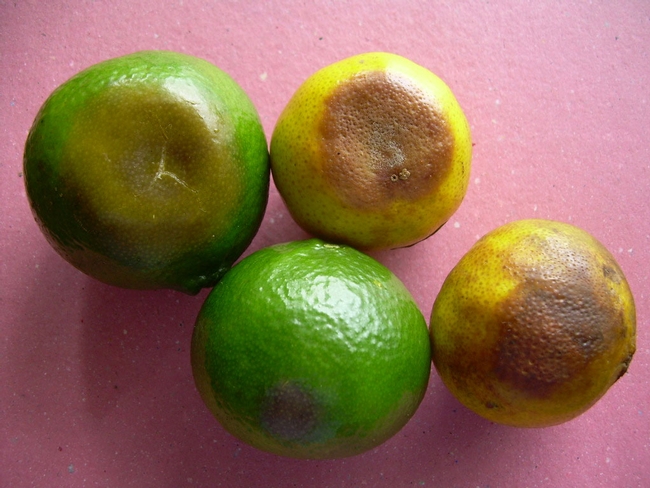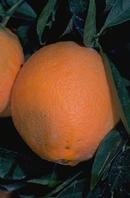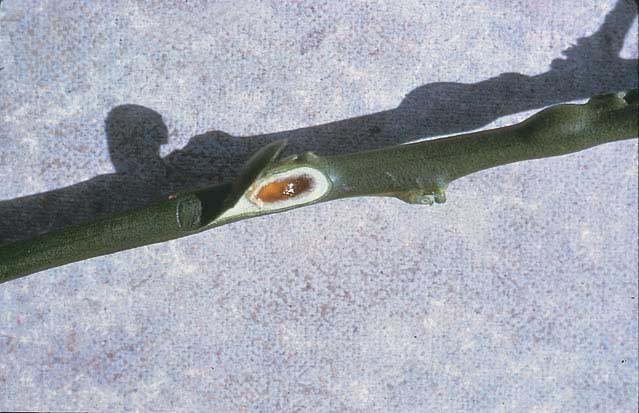- Author: Ben Faber
No rain for several years may have let citrus growers think that brown rot control is not important. But it still is and it's just coming out after a few inches of rain earlier this January. This is not the brown rot of stone fruits caused by Monilina fungus but a pathogen, completely different – Phytophthora spp.
Symptoms appear primarily on mature or nearly mature fruit. Initially, the firm, leathery lesions sometimes have a water-soaked appearance. Lesions are tan to olive brown, have a pungent odor, and may turn soft from secondary infections. Infected fruit eventually drop. Occasionally, twigs, leaves, and blossoms are infected, turning brown and dying.
Brown rot is caused by multiple species of Phytophthora when conditions are cool and wet. Brown rot develops mainly on fruit growing near the ground when Phytophthora spores from the soil are splashed onto the tree skirts during rainstorms; infections develop under continued wet conditions. Fruit in the early stage of the disease may go unnoticed at harvest and infect other fruit during storage.
Brown rot management primarily relies on prevention. Pruning tree skirts 24 or more inches above the ground can significantly reduce brown rot.
One spray of copper fungicide between October and December before or just after the first rain may provide protection throughout the wet season. When rainfall is excessive, you may have to repeat the spray in January or February. Spray the skirts to about 4 feet above ground. Spraying the ground underneath the trees also reduces brown rot infections. In addition to copper, other products effective against brown rot include the phosphonate and phenylamide fungicides. Phosphonates are applied as foliar and fruit or soil treatments, whereas phenylamides are applied as soil treatments for brown rot control. For soil applications, microsprinkler irrigation applications may be used.
Recently, oxathiapiprolin (Orondis®) was registered for use on citrus in California. Orondis® is an outstanding alternative for Phytophthora control that may be applied as chemigation or foliar application. However, foliar applications are preferred for preventing brown rot.
Postharvest Packinghouse Treatments to Prevent Fruit Decay
Potassium phosphite fungicides may be applied in aqueous dilutions to fruit alone or in combination with other postharvest fungicide treatments to manage nonvisible infections that occurred before harvest or protect fruit from brown rot infection after harvest during storage, distribution, and marketing. Use high-volume flooder or dip treatments for maximum coverage of fruit. Heated (125–136°F) fungicide solutions optimize performance of the potassium phosphite treatment.
More citrus brown rot information is at:
http://ipm.ucanr.edu/PMG/r107100711.html
Packers should check the Global MRL Database for all country MRLs at https://globalmrl.com/db#pesticides/query.
Photos of brown rot on different citrus varieties - lemon, mandarin, orange



- Author: Ben Faber
A 'Meyer' lemon should be quite happy along the coast, unless it gets planted in new soil that has low copper because of high soil pH or high organic matter. And then you wonder what is wrong.
Mild copper deficiency is usually associated with large, dark green leaves on long soft angular shoots. Young shoots may develop into branches which appear curved or “S-shaped," referred to as “ammoniation” usually resulting from excessive nitrogen fertilization. It's actually thought to be too much nitrogen relative to copper in the plant and can be corrected by foliar sprays. Twigs can develop blister-like pockets of clear gum at nodes. As twigs mature, reddish brown eruptions may occur in the outer portion of the wood. It can be quite shocking. Severely affected twigs commonly die back from the tip with new growth appearing as multiple buds or “witches broom”. Necrotic-corky areas on the fruit surface may sometimes occur in extreme situations. In some cases fruit cracking occurs with exudates.
Copper deficiency is more likely to occur in new plantings on previously uncropped soils, which are usually deficient or totally lacking in copper. In California, it has been referred to as “corral” disease or “midden” disease because it is associated with high organic matter that ties up the copper, or old Native American sites were debris had been piled. It is often localized in certain areas. Once I saw it on nursery trees that had had inadequate copper in the nutrient solution. I've only seen it on citrus, and not any other subtropical like avocado, but that doesn't mean it can't happen.
I've also seen gummosis similar to this occurring with drought and water management. It more commonly occurs as a twig die back at the tips. And certainly Phytophthora gummosis will show gumming. It's that little gumming pocket under the bark is usually the way to distinguish copper deficiency from these two others.
Pictures: pocket gumming (U. of Florida), oozing (Yara), gumming, and more gumming not a worm







